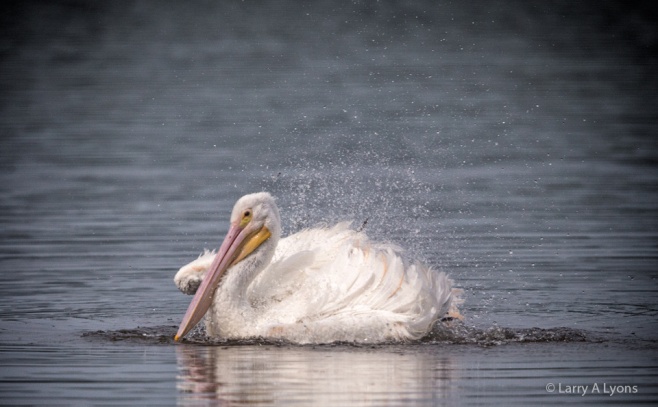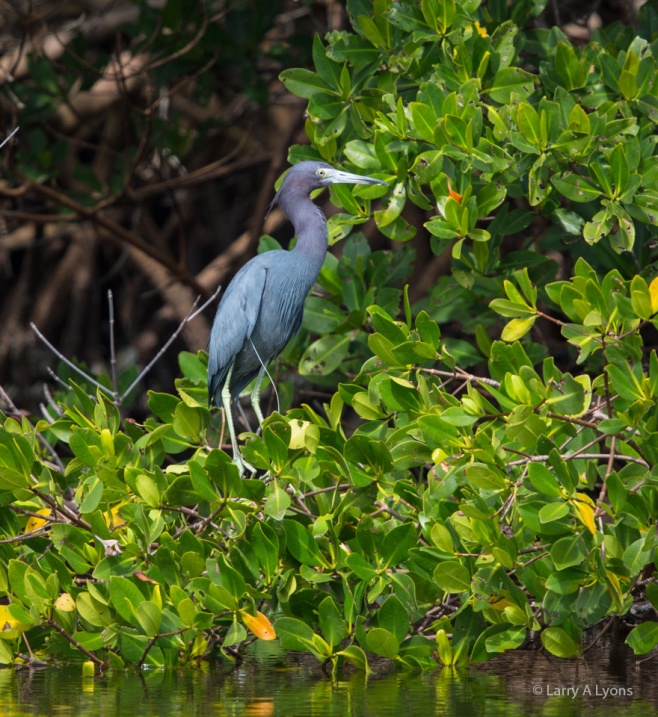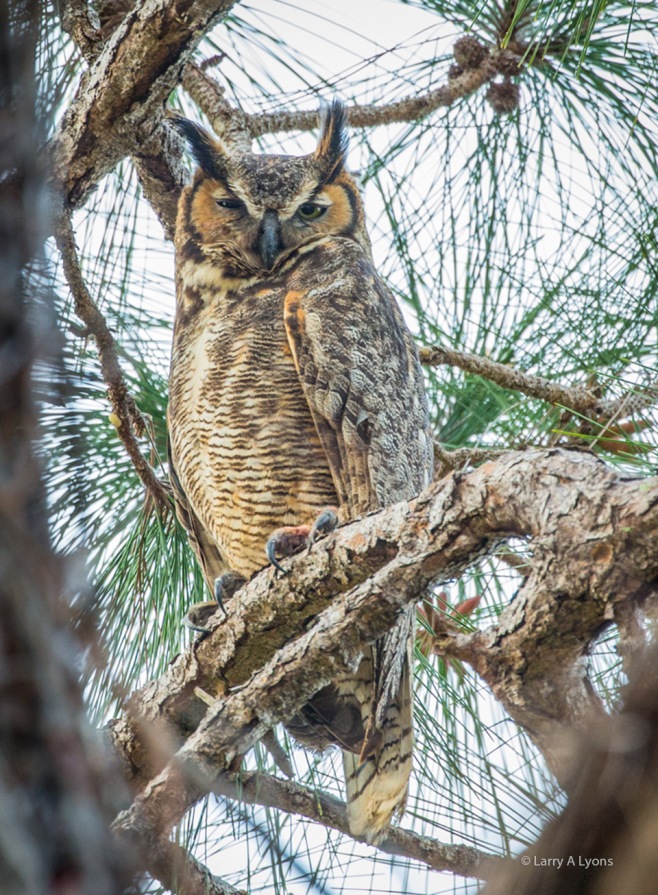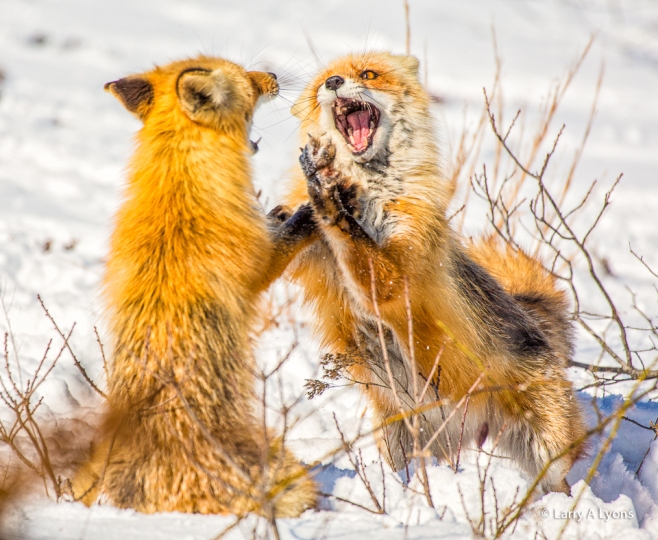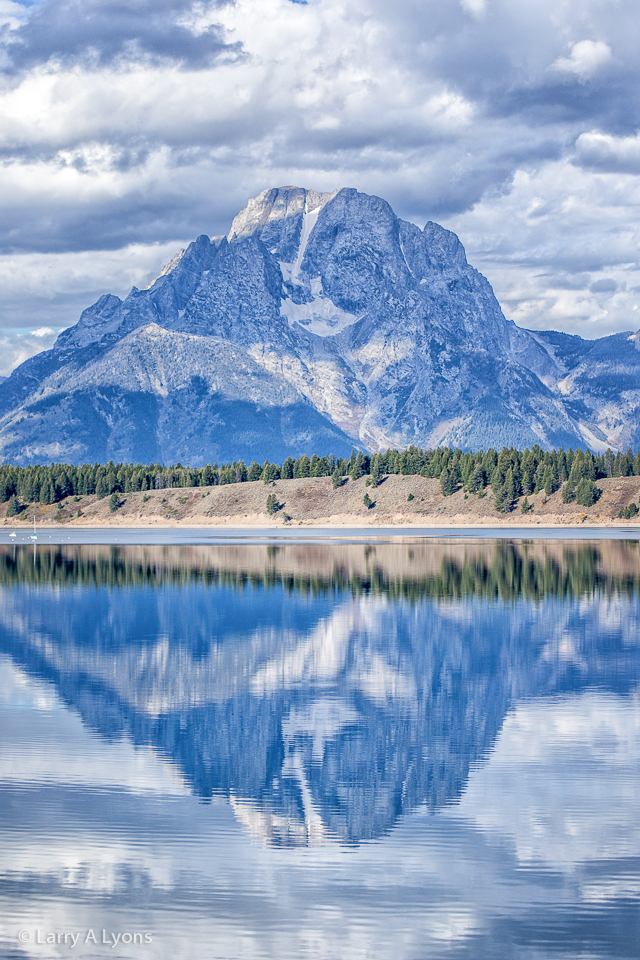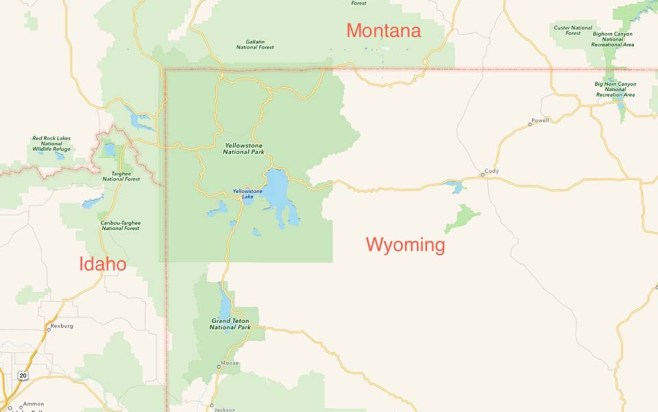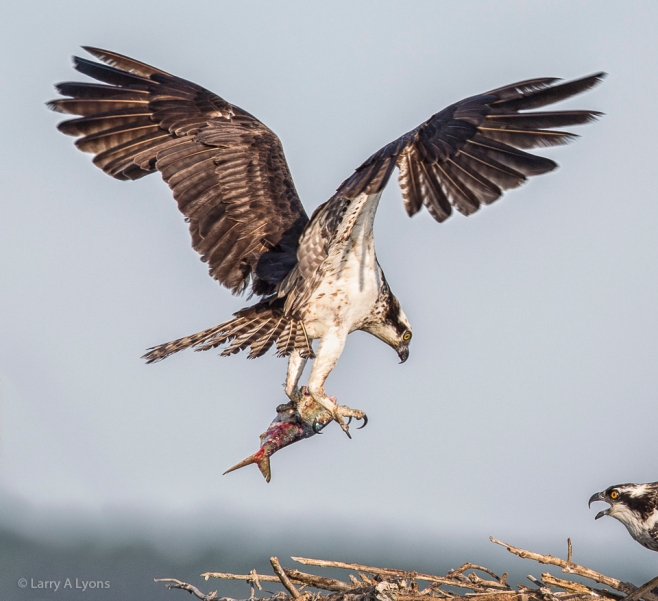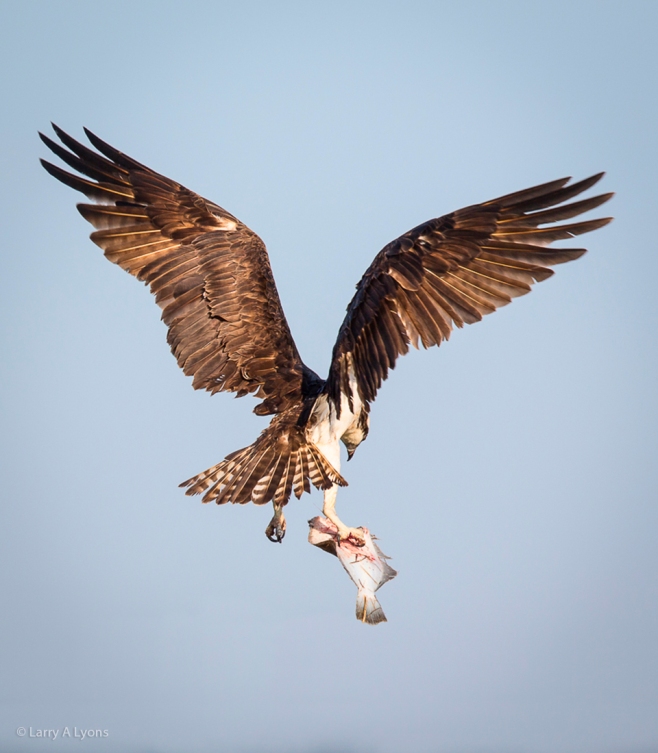Never underestimate what a nature park can offer and teach you. Take for example a nature park situated in New Jersey just across from the City of Philadelphia.
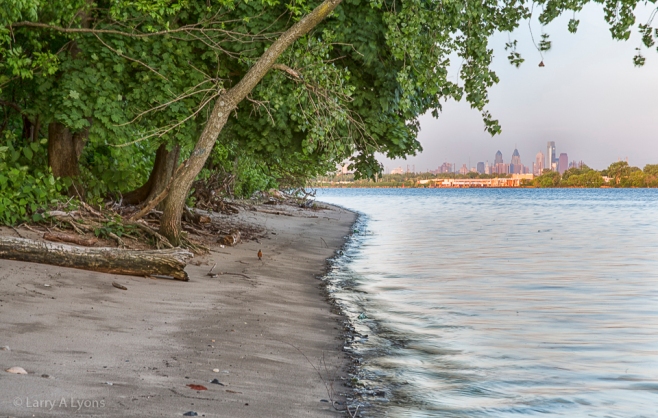
‘View of Philadelphia’ © Larry A Lyons
The Palmyra Cove Nature Park (www.palmyracove.org) is a 350 acre site located within a highly developed urban and commercial area in southern New Jersey. The park is bordered along the Delaware River just south of the Tacony-Palmyra Bridge.

‘Tacony-Palmyra Bridge’ © Larry A Lyons
Five field trips to the Palmyra Cove Nature Center during the spring of 2013 provided an opportunity to observe and photograph an amazing diversity of organisms and their behavior.

‘Great Horned Owl and Fledging’ © Larry A Lyons
Let’s begin with the Great Horned Owl. This owl is one of the largest owls in North America and one of the most ferocious birds of prey. Both sexes tend to look similar, but the female is 10 to 20 percent larger than the male.

‘Female Great Horned Owl’ © Larry A Lyons
Distinguishing features of the great horned owl are long ear tufts, intimidating stares with their yellow eyes, and densely feathered toes with dark horned claws. General coloration does vary between the owls.

‘Male Great Horned Owl’ © Larry A Lyons
A pair of Great Horned Owls selected a nesting site high up in the crotch of a cottonwood tree. Nesting begins as early as January or February and the female will typically lay two eggs. After hatching the nestlings are unable to fly for ten to twelve weeks, but the owlets will venture to nearby trees.

‘Owlet One’ © Larry A Lyons
One of the owlets remained in the original nesting site while the other owlet had moved to a lower a branch.

‘Owlet Two’ © Larry A Lyons
Both owlets are being cared for by both parents and remain dependent for food until the fall.

‘Ferocious Predator’ © Larry A Lyons
Great horned owls are ferocious predators and will hunt and eat all sorts of small and medium sized mammals (mice, squirrels, opossums, bats, and skunk). It will also eat small and large birds, including Canada geese, herons, ducks, and turkey. Owl prey can also be raccoon.

‘Young Raccoon’ © Larry A Lyons
It was amazing but only 20 feet away from the tree where the owlets were being raised were raccoons residing within a tree hollow.

‘Raccoon Sleeping’ © Larry A Lyons
Raccoons, like great horned owls, are nocturnal and tend to sleep during the daytime. This one was resting in a vertical position in the hollow of the tree.

‘Tree Hollow Home’ © Larry A Lyons
Trekking around the ponds at Palmyra Cove Nature Park can provide some great opportunities to observe birdlife and some interesting and bizarre behaviors. One such encounter involved a courting encounter amongst blue-winged teals.
Blue-winged teals are known to be the last duck to migrate north in the spring throughout most of the United States. Once they arrive in their northern breeding areas, pairs of teals will settle in vegetated wetlands and ponds to begin the next generation.

‘Pair of Blue-Winged Teals’ © Larry A Lyons
Blue-winged teals are monogamous during the mating season and are known to have some exaggerated behavior when courting. One such encounter was when another male attempted to intrude upon this pair of teals.

‘One Male Too Many’ © Larry A Lyons
The paired male quickly made it quite clear by grasping the beak of the intruder.

‘The Attack’ © Larry A Lyons
The intruder was able to pull its beak away from the grasp and then was aggressively chased away.

‘The Chase’ © Larry A Lyons
Blue-winged teal are so named because both sexes have some blue feathers on their forewings, but really cannot be seen until they are taking off or in flight. The male, on the other hand, is distinguished with slate gray head and neck and white crescent in front of the eyes.

‘Phew! Got Away’ © Larry A Lyons
Palmyra Cove Nature Center has a frog pond that is inhabited or utilized by several different amphibians. One unusual amphibian that only visits the pond once a year to breed is the Fowler’s Toad. The Fowler’s Toad is generally terrestrial and nocturnal except when this amphibian is in breeding mode. So, come spring to early summer, Fowlers’ Toads will venture out from the nearby woods to a wetland or shallow pond to breed. The male toad, measuring about two to three inches in size (5.1 to 7.5 cm.), will produce a call to attract the females.

‘Fowler’s Toad Calling’ © Larry A Lyons
The toads will proceed into what is referred to as amplexus, also known as the “Latin Embrace”. This embrace is a form of pseudocopulation where the male grasps the female with his front legs. The male then releases a fluid with sperm into the water and externally fertilizes the female eggs. The female lays eggs in clutches up to 25,000 eggs.

‘Latin Embrace’ © Larry A Lyons
There were hundreds of toads in the pond participating in this breeding ritual on this particular day. However, on a return trip of the following week, there was not a single toad to be seen, but there must had been thousands of tadpoles (about one half inch in size) swimming in the pond. Metamorphosis from tadpole to young toad occurs within two months.
The frog pond is also shared with other amphibians, such as, the green frog. This green frog surely would have found the eggs and the tadpoles of the Fowler’s Toad a tasty meal. It is all part of nature.

‘Green Frog’ © Larry A Lyons
Canada geese are so common that their increasing populations have become a nuisance at some locations. However, even though their presence is often taken for granted, their behaviors and their life history are quite interesting.

‘Canada Goose’ © Larry A Lyons
Canada geese do pair for life and will remain together over the entire year. In the spring, pairs of Canada geese will separate from their flocks and establish territories to start the next generation.
When a goose intrudes into a pairs’ territory, a lot of commotion will evolve in which the male will aggressively challenge the intruder by honking loudly, hissing with their beaks open wide and will even grab and collide between each other.

‘No Intruder Allowed’ © Larry A Lyons
The female is responsible for building the nest and incubating the eggs while the male will be nearby guarding the nest. After the goslings hatch they will remain close to their parents.

‘Canada Goose Goslings’ © Larry A Lyons
Canada geese are herbivores and will feed on grasses, sedges, berries, etc. This gosling has learned quickly what is good to eat.

‘Gosling Browsing’ © Larry A Lyons
White-tailed deer is another common resident not only at the Palmyra Cove Nature Center, but also throughout the woodlands and suburbs particularly within northeastern United States. The deer are usually best seen in the early morning or at dusk when they are browsing along the edges of woodlands.

‘Young White-Tailed Deer’ © Larry A Lyons
Their winter or early spring coats are brownish grey but they will turn to reddish-brown in the summer. The female deer (doe) stands at about 3 feet at shoulder height and will weigh up to 100 pounds.

‘White-Tailed Deer’ © Larry A Lyons
White-tailed deer are herbivores and will forage on a wide diversity of plants, including agricultural crops, at a rate of 2 to 7 lbs. per 100 lbs of body weight each day.

‘Doe Close-up’ © Larry A Lyons
White-tailed deer populations do present significant concerns that have caused negative effects to the deforestation of woodlands. Deer-related collisions with vehicles have also been an increasing problem with the overpopulation of deer. Attempting to maintain or manage deer populations at densities that will not be detrimental has become more and more challenging.

‘Drake Mallard’ © Larry A Lyons
No nature park is without mallards, the most common duck in the United States. The female mallard lays an average of nine eggs and is responsible for incubating the eggs and taking care of the ducklings.

‘Female Mallard and Ducklings’ © Larry A Lyons
To reiterate the take home message of this post: Don’t underestimate what a nature park can offer and teach you. Here was a nature park situated in a highly dense urban area that provided an incredible assortment of habitats. The combination of these habitats allowed for the propagation and sustainability of a diversity of wildlife from amphibians to owls, ducks, songbirds and geese to deer and raccoons.
Let’s get our children outdoors and away from their electronic devices. Let them find hidden habitats and enjoy the many wonders of nature. It is “our” next generation that will be responsible for continuing efforts to protect wildlife and maintain a commitment for preserving habitats.
Observe, enjoy, learn and, if you are so inclined, photograph them.

“A Birder’ © Larry A Lyons
References:
http://www.palmyracove.org
http://animaldiversity.ummz.umich.edu/
http://srelherp.uga.edu/anurans/buffow.htm
http://njaes.rutgers.edu/pubs/fs1202/white-tailed-deer.asp
http://www.allaboutbirds.org/




















